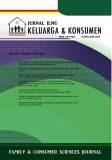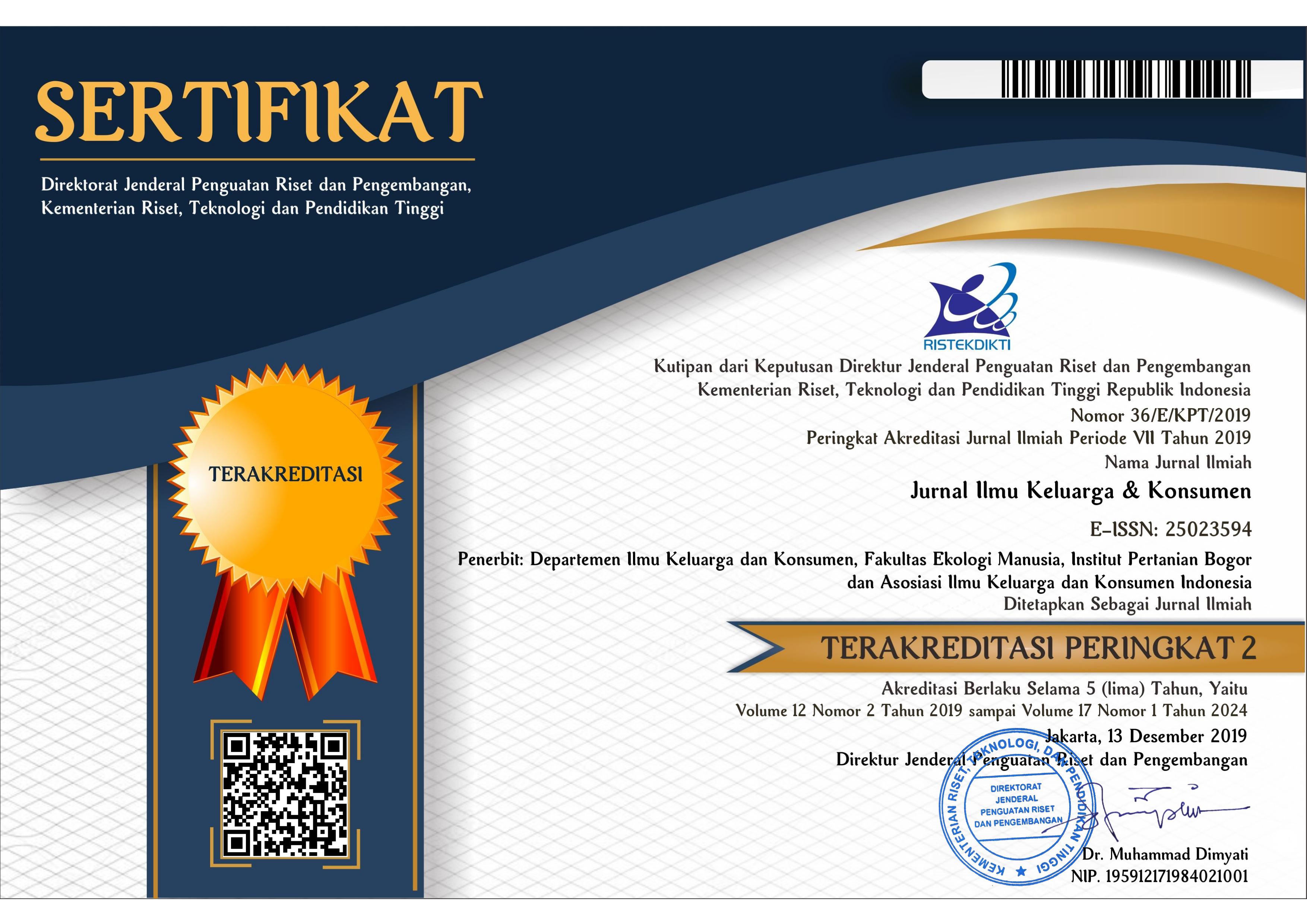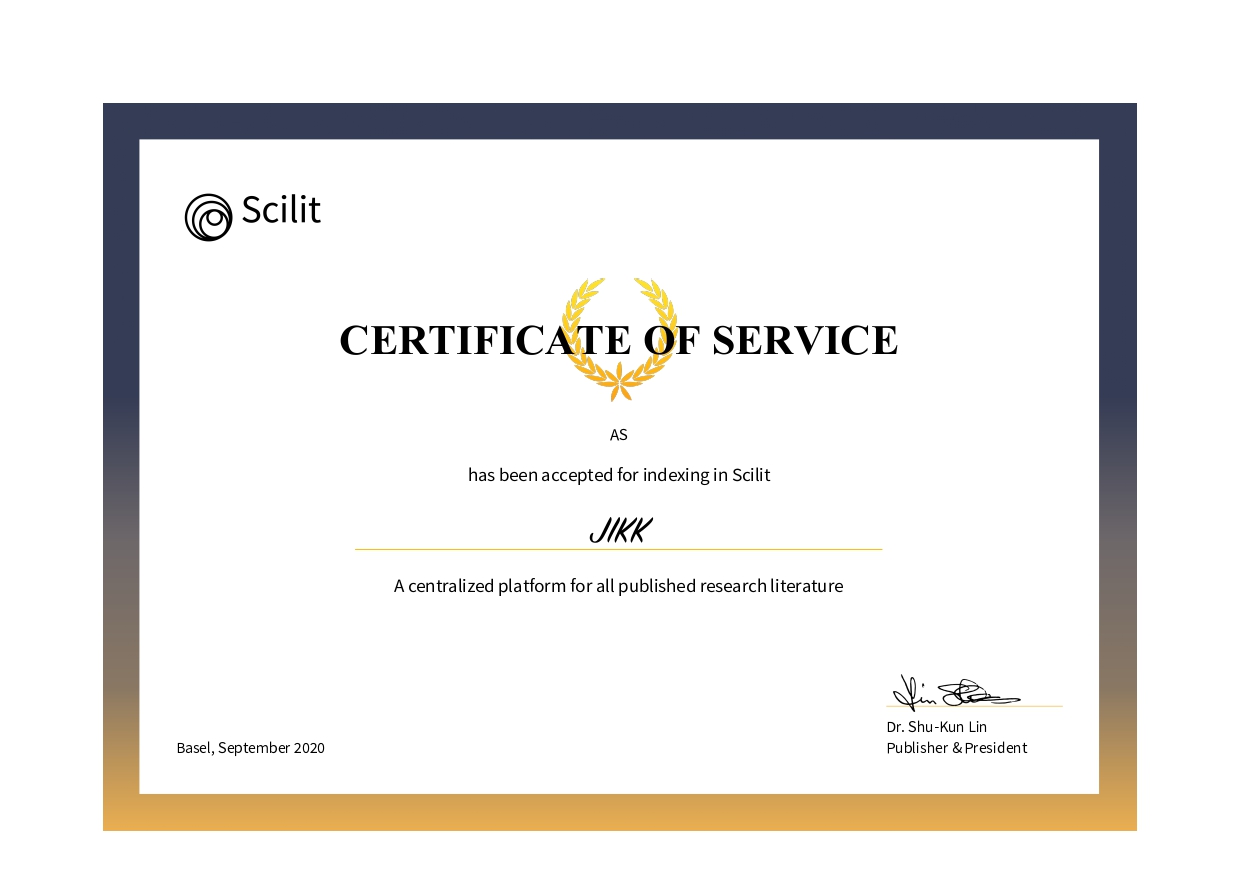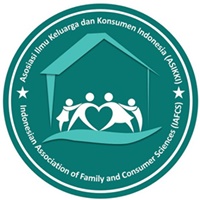Resiliensi Remaja: Perbedaan Berdasarkan Wilayah, Kemiskinan, Jenis Kelamin, dan Jenis Sekolah
Abstract
World’s current conditions which are full of uncertainties, threats, dangers and other problems lead the youth to become tougher and resilient in facing any kind of adversity. This study aimed to analyze the differences of resiliency of adolescents by region, poverty, gender, and type of school. This study was a quantitative study and involved 120 adolescents who were selected using multistage random sampling technique. Primary data were obtained by questionnaires which have been developed by researchers. The results showed that teenagers in the urban areas were more exposed to free-sex, freely skipping school, and involved with alcohol, whereas adolescents in the rural area more often experienced an invitation to use drugs. Female adolescent were more often to be invited and forced to be involved in free-sex, whereas male were more frequent involved in smoking and brawl. The portrait of resilience showed that in general the resilience of adolescents in rural areas and those who were schooling in vocational were higher than vice versa. There was no significant difference of resilience between male and female adolescents. However, in particular, the cooperation and communication of male adolescents is higher than for female, while female have higher ability of problem solving and empathy.References
Anasuri, S. (2016). Building resilience during life stages: current status and strategies. International Journal of Humanities and Social Sciences 6(3): 1-9. http://www.ijhssnet.com/journals/Vol_6_No_3_March_2016/1.pdf
Artuch-Garde, R., González-Torres, MdC., de la Fuente, J., Vera, M.M., Fernández-Cabezas, M., & López-García, M. (2017). Relationship between resilience and self-regulation: a study of Spanish youth at risk of social exclusion. Frontiers in Psychology. 8:1-11, DOI:: 10.3389/fpsyg.2017.00612
Bai, S., & Repetti, R. L. (2015). Short-term resilience processes in the family. Family Relation. 64(1): 108-119. DOI: 10.1111/fare.12101
Blum, R.W., Linda, H., Trish, B., Ernest P, M.D., Sheila, C.F., & Anneke, V. (2003). Adolescent health in the caribbean: risk and protective factors. American Journal of Public Health 93(3):456–460. https://www.ncbi.nlm.nih.gov/pmc/articles/PMC1447763/pdf/0930456.pdf
Bronfenbrenner, U. (1979). The Ecology of Human Development. USA: Harvard University Press.
Campbell, S.B., Shaw, D.S., & Gilliom, M. (2000). Early externalizing behavior problems: Toddlers and preschoolers at risk for later maladjustment. Development and Psychopathology, 12:467–488. [PubMed: 11014748] DOI: 10.1017/S0954579400003114
Chung, H,L., & Laurence, S. (2006). Relations between neighborhood factors, parenting behaviors, peer deviance, and delinquency among serious juvenile offenders. Developmental Psychology 42(2): 319–331,DOI:10.1037/0012-1649.42.2.319.
Culyba, A.J., Ginsburg, K.R., Branas, C.C., Richmond, T.S., & Wiebe, D.J. (2016). Protective effects of adolescent-adult connection on male youth in urban environment. Journal of Adolescent Health, 58 (2), 237-240. DOI: 10.1016/j.jadohealth.2015.10.247
Delva, J., Wonhyung L., Ninive S, Fernando H. Andrade., Andrew G,K., Guillermo S., & Michelle H. (2014). Ecological factors and adolescent marijuana use: results of a prospective study in Santiago, Chile. International Journal of Environmental Research and Public Health, (11): 3443-3452, DOI: 10.3390/ijerph110303443
Dias, P.C., & Irene Cadime. (2017). Protective factors and resilience in adolescents: The mediating role of self-regulation. Psicología Educativa 23:37–43. DOI: 10.1016/j.pse.2016.09.003
Eisman, A.B., Stoddard, S.A., Heinze, J., Caldwell, C.H., & Simmerman, M.A. (2015). Depressive symptoms, social support and violence exposure among urban youth: a longitudinal study of resilience. Developmental Psychology 51(9): 1307–1316, DOI: 10.1037/a0039501
Fergus, S., & Zimmerman, Marc A. (2005). Adolescent resilience: a framework for understanding healthy development in the face of risk. Annual Review of Public Health 2005. 26:399–419 doi: 10.1146/annurev.publhealth.26.021304.144357
Finigan-Carr, N.M., Tina L.C., Andrea G., Denise L.H., & Bruce S.M. (2015). Using the theory of planned behavior to predict aggression and weapons carrying in Urban African American early adolescent youth. Health Education Behavior 42(2): 220–230. doi:10.1177/1090198114548479. Fleming, J., & Ledogar, R. J. (2008). Resilience, an evolving concept: a review of literature relevant to aboriginal research. Pimatisiwin, 6(2), 7–23. https://www.ncbi.nlm.nih.gov/pmc/articles/PMC2956753/
Folke, C., S. R. Carpenter, B. Walker, M. Scheffer, T. Chapin, & J. Rockström. (2010). Resilience thinking: integrating resilience, adaptability and transformability. Ecology and Society 15(4): 20. [online] URL: http://www.ecologyandsociety.org/vol15/iss4/art20/
Gonzalez-Torres, M. C., & Artuch, R. (2014). Resilience and coping strategy profiles at university: contextual and demographic Variables. Electronic Journal of Research in Educational Psychology, 12(3), No. 34: 621–648, DOI:10.14204/ejrep.34.14032
Haffejee, S., & Theron, L. (2017). Resilience processes in sexually abused adolescent girls: a scoping review of the literature. South African Journal of Science 113(9): 1-9. DOI: 10.17159/sajs.2017/20160318
Hardaway, C.R., Vonnie C.M., & Dana W. (2012). Exposure to violence and socioemotional adjustment in low- income youth: an examination of protective factors. Am J Community Psychol. 2012 March ; 49(0): 112–126, DOI:10.1007/s10464-011-9440-3.
Jenney, A., Alaggia, R., & Niepage, M. (2016). “The lie is that it’s not going to get better”: narratives of resilience from childhood exposure to intimate partner violence. International Journal of Child and Adolescent Resilience. 4(1): 64–76. https://tspace.library.utoronto.ca/handle/1807/77652
Komisi Perlindungan Anak Indonesia [KPAI]. Data Kasus Berdasarkan Klaster Perlindungan Anak, 2011-2016.http://bankdata.kpai.go.id/tabulasi-data/data-kasus-per-tahun/data-kasus-berdasarkan-klaster-perlindungan-anak-2011-2016
Khanlou, N., & Wray, R. (2014). A whole community approach toward child and youth resilience promotion: a review of resilience literature. International Journal of Mental Health Addiction 12: 64-79. DOI: 10.1007/s11469-013-9470-1
Mamaghania, N.K., Azadeh, P.A, & Seyed, R.M. (2015). Designing for improving social relationship with interaction design approach. Procedia - Social and Behavioral Sciences 201 (2015) 377 – 385. , DOI: 10.1016/j.sbspro.2015.08.190
McDonald, C.C., Janet A.D., Nancy K.A., Therese S.R. (2011). Community violence exposure and positive youth development in urban youth. Journal of Community Health36(6): 925–932, DOI:10.1007/s10900-011-9391-5, DOI: 10.1016/j.sbspro.2015.08.190
Miller-Lewis, L. R., Searle, A.K., Sawyer, M.G., Baghurst, P.A., Hedley, D. (2013). Resource factors for mental health resilience in early childhood: an analysis with multiple methodologies. Child Adolescent Psychiatry Mental Health 7(6): 1-23. DOI: 10.1186/1753-2000-7-6
Moore, J. (2013). Research Summary: Resilience and At-risk Children and Youth. National Center for Homeless Education (NCHE). http://www.serve.org/nche
Moos, B. S., & Moos, R. H. (2009). Family environment scale. California, US: mind garden. Diambil dari://www.mindgarden.com/products/fescs.htm.
Nicoll, W. G. (2014). Developing Transformative Schools: A Resilience Focused Paradigm for Education. The International Journal of Emotional Education 6(1):47-65. https://files.eric.ed.gov/fulltext/EJ1085706.pdf
Ombati, M., & Ombati, V. (2016). Sources of resilience for children and youth in residential slums of Eldoret city in Kenya. Chinese Sociological Dialogue 1(1): 48-65. DOI: 10.1177/2397200916667622
Rutter, M. (1993). Resilience: some conceptual considerations. Journal of Adolescent Health14 (8): 626-631. DOI: 10.1016/1054-139X(93)90196-V
Rutter, M. (2012). Resilience as a dynamic concept. Development and Psychopathology, 24, 335–344. DOI:10.1017/S0954579412000028
Ruvalcaba, N.A., Julia, G., Africa, B., & Noe, G. (2017). Extracurricular activities and group belonging as a protective factor in adolescence. Psicología Educativa, 23(1): 45-51. DOI: http://dx.doi.org/10.1016/j.pse.2016.09.001
Sagone, E. & Caroli, M.E. (2013). Relationship between resilience, self-efficacy, and thinking styles in Italian middle adolescent. Procedia-Social and Behavioral Sciences 92(10): 838-845. DOI: 10.1016/j.sbspro.2013.08.763
Sagone, E. & Caroli, M.E. (2014). A correlational study on dispositional resilience, psychological well-being, and coping strategies in university students. American Journal of Educational Research, 2: 463-471. DOI: 10.12691/education-2-7-5
Sagone, E. & Caroli, M.E. (2015). Positive personality as a predictor of high resilience in adolescence. Journal of Psychology and Behavioral Science 3(2), 45-53. DOI: 10.15640/jpbs.v3n2a6 Stoddard, S. A., Whiteside, L., Zimmerman, M. A., Cunningham, R. M., Chermack, S. T., & Walton, M. A. (2013). The Relationship between Cumulative Risk and Promotive Factors and Violent Behavior among Urban Adolescents. American Journal of Community Psychology, 51(0), 57–65. http://doi.org/10.1007/s10464-012-9541-7
Sunarti, E. (2001). Studi ketahanan keluarga dan ukurannya: telaah kasus pengaruhnya terhadap kualitas kehamilan. (Disertasi), Institut Pertanian Bogor, Bogor, Indonesia
Sunarti, E. (2009). Ekosistem keluarga. Naskah Akademis Pengembangan Model Ecovillage. Bogor: Crestpent Press
Sunarti, E. (2015). Ketahanan Keluarga Indonesia: Dari Kebijakan dan Penelitian menuju Tindakan. Buku Orasi Ilmiah Guru Besar IPB. IPB Press.
Sunarti, E. (2017). Model Kampung Ramah Keluarga di Kota Bogor. Laporan Kajian. Tidak dipublikasikan.
The Center for the Study of Social Policy (CSSP). (2005). Youth Resilience: Protective and Promotive factors. available at http://www.cssp.org/reform/strengtheningfamilies/practice/body/HO-3.1e-YT_Youth-Resilience.pdf
Uslu, A., & Gokce, A. (2010). Social interaction in urban transformation areas and the characteristics of urban outdoor spaces: a case study from Turkey. African Journal of Agricultural Research 5(20): 2801-2810. Diakses pada:http://www.academicjournals.org/AJAR
Vanderbilt-Adriance, E., & Shaw, D. S. (2008). Protective Factors and the Development of Resilience in the Context of Neighborhood Disadvantage. Journal of Abnormal Child Psychology, 36(6), 887–901. http://doi.org/10.1007/s10802-008-9220-1
Willgerodt, M,A. (2008). Family and peer influences on adjustment among Chinese, Filipino and White Youth. Nursing Research 57(6): 395–405, DOI:10.1097/NNR.0b013e3181907175. Zimmerman, M. A., Stoddard, S. A., Eisman, A. B., Caldwell, C. H., Aiyer, S. M., & Miller, A. (2013). Adolescent Resilience: Promotive Factors That Inform Prevention. Child Development Perspectives, 7(4): 215- 220, DOI: 10.1111/cdep.12042.
Copyright (c) 2018 Jurnal Ilmu Keluarga & Konsumen

This work is licensed under a Creative Commons Attribution-ShareAlike 4.0 International License.
Authors submitting manuscripts should understand and agree that copyright of manuscripts published are held Jurnal Ilmu Keluarga dan Konsumen. The statement to release the copyright to Jurnal Ilmu Keluarga dan Konsumen is stated in Copyright Release Form. Copyright encompass exclusive rights to reproduce, to distribute, and to sell any part of the journal articles in all form and media. The reproduction of any part of this journal is allowed with a written permission from Jurnal Ilmu Keluarga dan Konsumen.









